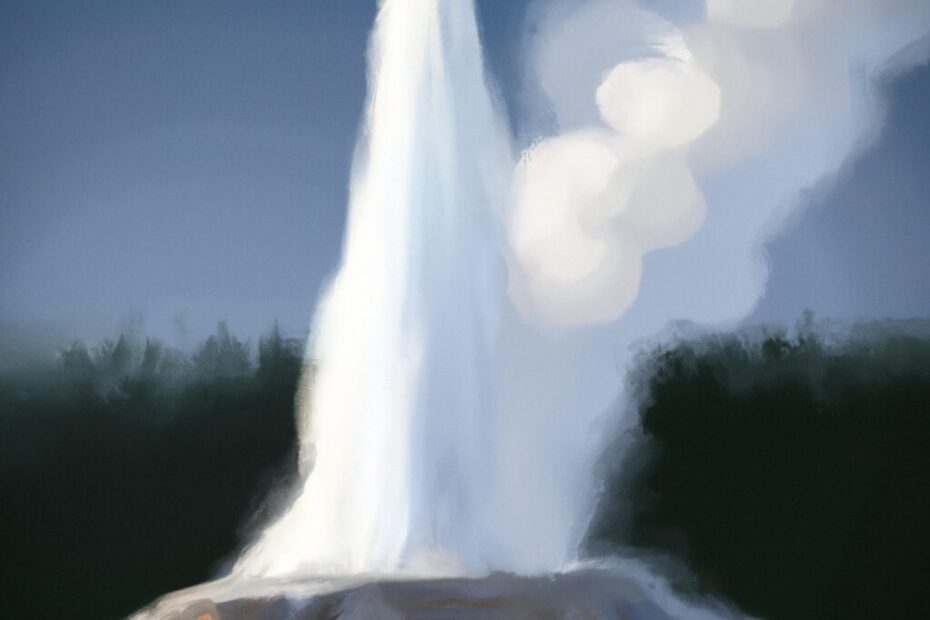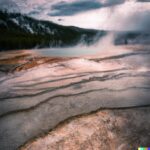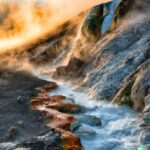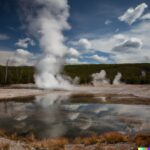Have you ever heard of the Old Faithful Geyser Basin? Located in Yellowstone National Park, this unique natural wonder is known for its consistent eruptions, distinctive shape, and mesmerizing thermal features.
In this article, we will explore what makes Old Faithful Geyser Basin so special, the main attractions to see, how it was formed, the best time to visit, and safety precautions to keep in mind. Get ready to discover the magic of this geothermal marvel!
What Is Old Faithful Geyser Basin?
Old Faithful Geyser Basin is a renowned geothermal area within Yellowstone National Park, known for its impressive eruptions and unique hydrothermal features.
This geological wonder is fueled by the underlying volcanic activity that heats water deep within the Earth’s crust, creating the perfect conditions for the geothermal features to flourish. The hydrothermal system at Old Faithful Geyser Basin is a fascinating display of nature’s power, with geysers shooting water high into the air, bubbling hot springs, and colorful mineral deposits lining the pools.
Tourists flock to the area to witness these spectacular displays of natural phenomena, mesmerized by the rhythmic eruptions of the named Old Faithful geyser and the unpredictable beauty of the surrounding thermal features.
Where Is Old Faithful Geyser Basin Located?
Old Faithful Geyser Basin is situated within the captivating expanse of Yellowstone National Park, known for its diverse geology, including the Yellowstone Caldera and numerous hydrothermal areas.
The park’s unique geological features were shaped by the presence of the massive Yellowstone Caldera, a supervolcano that underlies much of the park. This caldera is one of the largest active volcanic systems in the world, influencing the park’s landscape with its impressive geothermal activity.
The distribution of hydrothermal areas in the region, like hot springs, geysers, and mud pots, showcase the park’s dynamic underground thermal features.
Visitors to Old Faithful Geyser Basin can witness the power and beauty of nature as they observe the mesmerizing eruptions of the iconic Old Faithful geyser.
What Makes Old Faithful Geyser Basin Unique?
Old Faithful Geyser Basin stands out due to its regular eruption cycle, stunning hot springs, diverse geothermal features, and the ability to predict the timing of its eruptions.
Visitors to the basin are often mesmerized by the rhythmic eruptions of Old Faithful, which occur approximately every 90 minutes, shooting skyward with impressive force and consistency. The vivid colors of the hot springs create a captivating contrast against the surrounding landscape, showcasing hues ranging from vibrant blues to fiery oranges. As you wander through the basin, you’ll encounter bubbling mud pots, fumaroles emitting steam and gases, and terraces adorned with intricate mineral formations, all testaments to the complex geological processes at work beneath the surface.
Consistent Eruptions
One of the key features that make Old Faithful Geyser Basin remarkable is its consistent eruption cycle, allowing for accurate timing predictions based on underlying geological processes.
This regularity stems from the unique combination of factors within the basin. The underground plumbing system of interconnected chambers and conduits plays a crucial role in maintaining the cycle. As the superheated water rises through these channels, the pressure builds until it breaks through the surface, resulting in the spectacular eruptions we witness. Geologists use data on past eruptions, temperature fluctuations, and water levels to fine-tune their predictions. Such predictability not only attracts tourists but also facilitates scientific research on geothermal activity and volcanic processes.
Distinctive Shape
The distinctive shape of Old Faithful Geyser Basin is a testament to the unique geological features of the region, shaped by the dynamic forces within the Yellowstone Caldera.
As you walk through Old Faithful Geyser Basin, you’ll notice the fascinating array of geothermal features that dot the landscape. The basin is home to a diverse collection of geysers, hot springs, and bubbling mud pots, each offering a glimpse into the powerful geological processes at work beneath the surface. The vibrant colors of the mineral-rich waters, steam rising from various vents, and the occasional eruption of the iconic Old Faithful geyser all combine to create a truly mesmerizing sight. The interplay of heat, water, and pressure shapes the terrain in a way that is both awe-inspiring and humbling.
Thermal Features
The thermal features of Old Faithful Geyser Basin are a result of intense geothermal activity, showcasing a complex hydrothermal system that gives rise to hot springs, unique hydrothermal features, and mineral deposits.
This hydrothermal system, fueled by magma deep within the Earth’s crust, heats the groundwater and creates a dynamic environment where hot springs form. These hot springs emerge when the heated water rises to the surface due to the pressure build-up, releasing steam and water that can reach temperatures well above boiling point.
The diversity of hydrothermal features in Old Faithful Geyser Basin includes geysers, fumaroles, mud pots, and travertine terraces, each exhibiting distinct characteristics shaped by the unique chemical composition of the dissolved minerals. As the superheated water cools upon reaching the surface, it deposits these minerals, creating stunning colorful formations that evolve over time.
What Are The Main Attractions At Old Faithful Geyser Basin?
Old Faithful Geyser Basin offers a multitude of attractions, with highlights including the iconic Old Faithful Geyser, the majestic Castle Geyser, the impressive Grand Geyser, and the picturesque Riverside Geyser.
Visitors are drawn to Old Faithful Geyser due to its reliable eruptions, where scalding water jets shoot up to nearly 200 feet in the air, captivating spectators with its rhythmic displays.
Castle Geyser, with its distinctive cone resembling a castle turret, provides a unique sight against the backdrop of the basin.
The Grand Geyser enchants onlookers with its powerful eruptions reaching up to 200 feet high, making it one of the tallest predictable geysers in the world.
Riverside Geyser, set against the idyllic Firehole River, offers a charming setting for visitors to witness its regular eruptions that create a beautiful natural spectacle.
Old Faithful Geyser
Old Faithful Geyser, the namesake of the basin, is renowned for its regular eruption cycle, predictable timing predictions, and spectacular displays of natural phenomena that captivate visitors.
This mesmerizing marvel erupts approximately every 90 minutes, shooting scalding water high into the air with a force that never fails to mesmerize onlookers. The eruption cycle of Old Faithful is a result of the build-up of pressure within the underground reservoir, causing the water to burst forth in a stunning display of nature’s power.
Park rangers utilize a combination of geological data and historical records to accurately forecast the timing of these eruptions, allowing visitors to witness this iconic spectacle up close. The sight of Old Faithful shooting steam and water skyward against the backdrop of Yellowstone’s scenic beauty is truly a sight to behold, making it a must-see attraction for any visitor to the park.
Castle Geyser
Castle Geyser, with its unique structure and silica-rich water, showcases distinctive geothermal features and thermal anomalies that contribute to its allure in Old Faithful Geyser Basin.
Its striking resemblance to a medieval castle, combined with the constant flow of silica-rich water, creates a mesmerizing sight for onlookers. The geyser’s eruptions are not only visually captivating but also scientifically intriguing due to the thermal anomalies present. Visitors are drawn to the geyser not just for its impressive displays but also for the opportunity to witness nature’s raw power up close. The dynamic interplay of geology and hydrothermal processes at Castle Geyser makes it a must-visit destination for those exploring Yellowstone’s geothermal wonders.
Grand Geyser
Grand Geyser, known for its majestic eruptions and boiling water displays, serves as a testament to the potent heat source that fuels the geothermal activity within Old Faithful Geyser Basin.
Its eruptions, reaching heights of up to 200 feet, are a spectacle to behold, captivating visitors with the sheer power and force of nature on display. The steam and mist created by the scalding water add an ethereal quality to the surroundings, creating an otherworldly atmosphere around the geyser. The underlying heat source, sourced from deep within the Earth’s crust, pulses with energy, demonstrating the resilience and dynamism of geothermal features.
As one of the major attractions in the area, Grand Geyser’s cyclical eruptions draw crowds eager to witness its natural wonders firsthand.
Riverside Geyser
Riverside Geyser, characterized by superheated water and an intricate underground plumbing system, undergoes a mesmerizing steam phase during its eruptions, captivating audiences with its natural beauty.
The superheated water of Riverside Geyser is an extraordinary sight to behold, reaching scorching temperatures beneath the surface before erupting into a spectacular display. This geyser is fueled by a complex network of underground channels and chambers that channel the scalding water to the surface, creating a dynamic and unparalleled natural phenomenon. As Riverside Geyser erupts, the steam phase adds an ethereal quality to the landscape, making it a must-see attraction for visitors who are drawn to the wonder and power of geothermal features.
How Was Old Faithful Geyser Basin Formed?
The formation of Old Faithful Geyser Basin can be attributed to past volcanic activity, ongoing hydrothermal processes, geological transformations, and the presence of a substantial water reservoir beneath the surface.
Long before Old Faithful became a renowned natural wonder, the region was shaped by ancient volcanic eruptions that deposited layers of igneous rock. These volcanic events laid the groundwork for the geothermal features present today. Over time, as the Earth’s crust shifted and the region underwent tectonic changes, the hydrothermal activity intensified. This activity is sustained by the underground water reservoir, which contributes to the pressure and heat necessary for the geyser eruptions and vibrant thermal features that captivate visitors from around the world.
Volcanic Activity
Old Faithful Geyser Basin’s origins trace back to significant volcanic activity in the region, particularly within the Yellowstone Caldera, which deposited sediments and established a potent heat source for the geothermal features seen today.
This volcanic activity, which dates back thousands of years, played a pivotal role in shaping the landscape and creating the unique geological formations that draw countless visitors each year. As the volcanic eruptions occurred, they left layers of ash, pumice, and other volcanic debris, forming the foundation for the basin’s thermal features. Over time, the intense heat generated by the underground magma reservoirs beneath the caldera created ideal conditions for the hot springs, geysers, and mud pots that make Old Faithful Geyser Basin a must-visit destination for nature enthusiasts and geology buffs alike.
Hydrothermal Processes
The continuous hydrothermal processes within Old Faithful Geyser Basin involve water interactions with the underground reservoir, leading to pressure buildup and the formation of bacterial mats that contribute to the unique ecosystem of the area.
As water seeps through the porous rock layers, it absorbs various minerals and gases, becoming superheated in the underground reservoir. The pressure dynamics created by the interactions between the heated water and trapped gases lead to periodic eruptions of geysers, hot springs, and fumaroles. These eruptions not only release steam and boiling water but also bring up dissolved minerals, which enrich the surrounding soil. The development of bacterial mats further enhances the ecosystem, providing a habitat for thermophilic microorganisms that thrive in the extreme conditions created by the hydrothermal features.
What Is The Best Time To Visit Old Faithful Geyser Basin?
Determining the best time to visit Old Faithful Geyser Basin involves considering factors such as timing predictions, temperature monitoring, the presence of thermal anomalies, and the understanding of eruption patterns.
Visitors can optimize their experience by planning their visit around the predicted eruption times, which are based on historical data and observation. The temperature of the geyser’s water is closely monitored since changes can indicate an imminent eruption. The presence of thermal anomalies, deviations in the expected temperature patterns, can offer insights into potential eruptions. Understanding the patterns of past eruptions helps visitors anticipate the spectacle and increases the chances of witnessing nature’s grand event at its most magnificent moment.
What Are The Safety Precautions At Old Faithful Geyser Basin?
Ensuring a safe visit to Old Faithful Geyser Basin involves adhering to specific safety guidelines, following park regulations, being mindful of the environmental impact, and supporting ongoing conservation efforts within the area.
- Visitors should always stay on designated boardwalks and trails to avoid the fragile thermal features and potential hazards. It’s essential to heed signage that indicates restricted areas to protect both visitors and the ecosystem.
- Keeping a safe distance from wildlife enhances both visitor safety and animal welfare. Carrying out any trash brought into the park and using designated waste disposal facilities are crucial steps in minimizing human impact on the environment.
Last Updated on February 11, 2024 by Jon Waraas – Originally Posted: February 11, 2024

I’m Jon Waraas, and I’ve been navigating the online world since 2006. By day, I’m the proud owner of some eCommerce gems, and by night, I’m the voice behind the adventures on Waraas.Com.
My heart, however, belongs to the wild beauty of Yellowstone National Park. I’ve got a collection of websites dedicated to sharing the wonders of this natural masterpiece. Oh, and did I mention? I’m currently building my own cabin inside the ghost town of Gilmore, Idaho – a cabin with tales to tell!
When I’m not immersed in the digital realm, you’ll find me lacing up my boots for a good hike or setting up camp under the star-studded sky.




